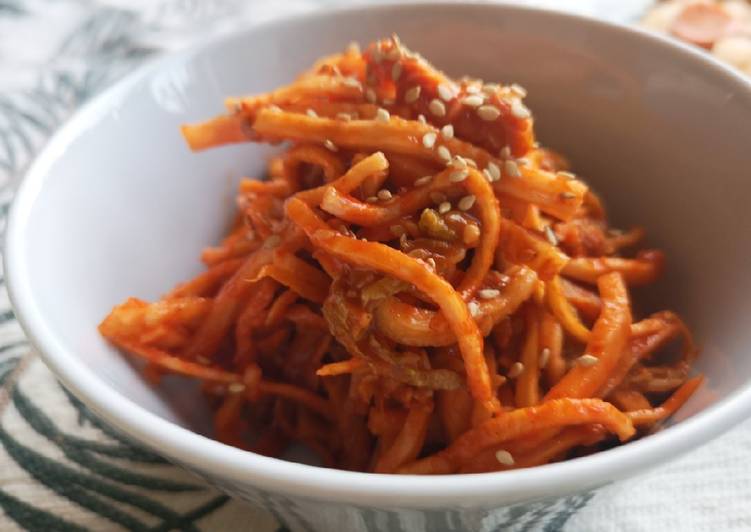Radish kimchi. Daikon radish, fish sauce, garlic, ginger, green onion, hot pepper flakes, korean radish, salt, sugar. Radish kimchi is a kimchi made out of radish and its Korean name is Kkakdugi (깍두기). The name originates from kkakduk sseolgi (깍둑설기) in Korean.
 It's an easy kimchi to make! Simply cut the radishes into cubes, salt for a short time, and then mix with the seasonings. Kkakdugi (깍두기) or diced radish kimchi is a variety of kimchi in Korean cuisine. You can cook Radish kimchi using 8 ingredients and 3 steps. Here is how you cook it.
It's an easy kimchi to make! Simply cut the radishes into cubes, salt for a short time, and then mix with the seasonings. Kkakdugi (깍두기) or diced radish kimchi is a variety of kimchi in Korean cuisine. You can cook Radish kimchi using 8 ingredients and 3 steps. Here is how you cook it.
Ingredients of Radish kimchi
- Prepare 1 of whole Radish (julienne slice).
- Prepare 200 gm of salt.
- It's 100 gm of fresh ginger (julienne slice).
- You need of Marinated kimchi base.
- Prepare 250 gm of Gochujang (korean chili paste).
- Prepare 1 tablespoon of fish sauce.
- Prepare 2 tablespoon of mirin.
- It's 1 tablespoon of roasted white sesame.
Usually, it has all the ingredients of kimchi, but the baechu (hangul: 배추; Napa cabbage) used for kimchi is replaced with Korean radish (called mu, 무 in Korean). Kkakdugi is a type of kimchi made with Korean radish ("mu" in Korean). Kkakdugi pairs well with soups like seolengtang (ox tail soup) and noodle. This young radish Kimchi - also known as Chong Gak (pronounced 'gaak') / Chongkak Kimchi -is definitely my favorite Kimchi of all because it has both great taste and great texture.
Radish kimchi step by step
- Mixed the salt with Radish and ginger. Marinated around 2 hours. After 2 hours, wash out the salt and press out the water from the Radish and ginger. Put a side, use it later..
- Mixed the the marinated base ingredients in a big bowl then add in the Radish and ginger slices into the bowl. Stir well until all the base combine..
- Store in a food container, keep in the fridge fir at least 48hours. Taste will be awesome..
Kimchi comes in all shapes and sizes, but this Kkakdugi (깍두기) made with large Korean radish is a perennial favorite. With crunchy cubes of radish in a sweet and spicy pickling sauce Kkakdugi goes. Korean radish is naturally filled with lots of juice. So when you salt it, it will release this juice into the thick Kimchi paste. You will end up with a small layer of refreshing Kimchi juice.
Comments
Post a Comment